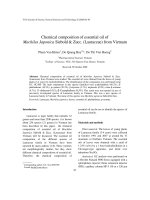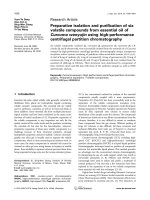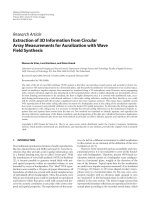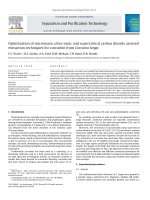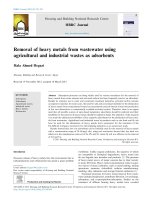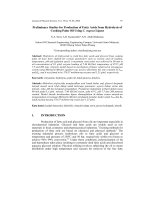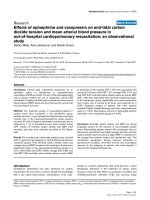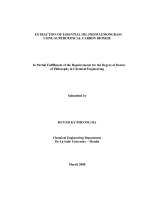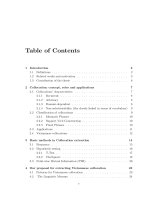extraction of essential oil from lemongrass using supercritical carbon dioxide
Bạn đang xem bản rút gọn của tài liệu. Xem và tải ngay bản đầy đủ của tài liệu tại đây (3.79 MB, 219 trang )
EXTRACTION OF ESSENTIAL OIL FROM LEMONGRASS
USING SUPERCRITICAL CARBON DIOXIDE
In Partial Fulfillment of the Requirements for the Degree of Doctor
of Philosophy in Chemical Engineering
Submitted by
HUYNH KY PHUONG HA
Chemical Engineering Department
De La Salle University – Manila
March 2008
ABSTRACT
The Supercritical Fluid Extraction (SCFE) process is a powerful technique to
develop for separating products with high added value. In this study, Supercritical
fluid Carbon Dioxide (SC CO
2
) was used in the extraction of essential oil from two
different parts of the lemongrass plant, the leaves and the stems.
The batch extraction process was carried out in a stand alone compact unit of
SCFE system. The lemongrass was loaded into the 500ml extractor with an up flow
rate of 0.5 m
3
per hour of CO
2
. The extraction temperature was varied from 35
0
C to
50
0
C while the extraction pressure applied was from 90 to 110 atmospheres and the
length of material was varied from 4 mm to 8 mm. The extraction time was set at 3.0
hours.
This study intends to compare the composition of essential oil extracted from
lemongrass leaves and lemongrass stems using SC CO
2
and Steam Distillation. The
extracts from both methods were analyzed by GC-MS and the variations of the
compositions were reported.
Furthermore, the study attempts to formulate statistical experimental design
using Design-Expert Software (version 7.0.1). The effects of temperature, pressure
and length of material were analyzed employing the Response Surface Methodology
(RSM) technique. The models of extraction for both leaves and stems were
established with the extraction yield and citral content of the essential oil at the
established responses. The optimum yields of essential oil from leaf and stem at the
given extraction conditions were also determined.
ii
ACKNOWLEDGMENTS
Firstly, I would like to express my grateful appreciation to the following
institutions and laboratories that made this research work possible:
Asian University Network / Southeast Asia Engineering Education and
Development Network (AUN/SEED-Network) and Japanese International
Cooperation Agency (JICA).
De La Salle University, Host Institution of Chemical Engineering in
AUN/SEED-Net program.
Ho Chi Minh City University of Technology.
Chemical Engineering Laboratory and Chemistry Department Laboratory of
De La Salle University (DLSU)– Manila.
Chemical Technology Laboratory of Mindanao State University – Iligan
Institute of Technology (MSU-IIT).
Laboratory of Tokyo Institute of Technology (TIT), and Kawasaki
Laboratory-TIT, Tokyo, Japan.
I would like to sincerely thank my research advisor, Prof. Dr. Julius B.
Maridable, Ph.D, Vice-Chancellor for Academics, DLSU, who kindly guided me on
how to conduct my research in the best way, who always took care of me not only as
a student but also as a son, who taught me not only knowledge in research but also
behavior in a new environment. Thank you for your advice, guidance, direction and
endless enthusiasm for the subject. I will forever look at you with deep awe and
respect and I am very fortunate and happy for having the chance to study as his
advisee.
Also, I would like to gratefully thank my advisor, Prof. Pag-asa D.
Gaspillo, Ph.D, Dean of the College of Engineering, who essentially inspired me to
do my best in performing my experiment as well as in writing my thesis and papers.
iii
Thank you for your appreciated support, valuable encouragement and considerable
recommendations for my thesis. I deepest thank you not only for the perfect
knowledge, but also for the nice working atmosphere, and the large experience
gathered there, which all serves as a stable basis for further scientific research. Thank
you for your kindly in reviewing my papers, presentations and manuscript. Thanking
you is not really enough to convey the gratitude I feel. I always have the deepest
respect for you.
Prof. Junjiro Kawasaki, Ph. D, my Japanese thesis adviser, who has taken
care of me as an adviser, Sensei, not only during the time I stayed and researched in
Japan but also in the Philippines. Thank you for kindly sharing your knowledge as
well as experience in research, Thank you for cherishing and supervising my
research, as well as my life throughout my stay at TIT. Thank you for being happy to
communicate your knowledge and experience to students, who always have the
deepest respect for you. I wish that you will always have good health.
Dr. Roberto M. Malaluan, my thesis co-adviser from Mindanao State
University – Iligan Institute of Technology (MSU-IIT), thank you for being an
anchor of strength during some of the most trying times of this research. Thank you
for giving me free reign in the supercritical laboratory. Thank you for unselfishly
sharing with me your veritable knowledge in the supercritical area, which proved to
be very essential for my research, and for always appreciating the works
accomplished.
From my heart, I deeply thank the members of my Thesis Examination
Panel for their valuable time, comments and suggestions to improve my research:
Prof. Dr. Leonila C. Abella, Chair of the panel, Prof. Dr. Raymond G. Tan, Prof.
Dr. Bonifacio Doma, Prof. Dr. Jonathan Salvacion, Dr. Carmela Centeno and
iv
Prof. Dr. Servillano Olano Jr., for his comments and suggestions during the
proposal defense.
Maraming salamat Po.
I would also like to extend my deepest gratitude to:
Ms. Gladys Paz Cruz, coordinator of AUN/SEED-Net scholars, for being
very supportive and encouraging during my two years in the Philippines. Thank you
for helping me every time, especially when I had concerns. Thank you for your
warmth and kindness in helping me not only as a scholar but also as a brother. Best
Wishes to You and Your Family!
Ms. Marie Ann Mercado, for your help during my studies at DLSU.
Prof. Hitoshi Kosuge and Dr. Hiroaki Habaki, TIT for your help during
the time I stayed in Tokyo and for your advising in my research as well as in writing
my paper.
Thank you to all faculty members from the ChE Department of DLSU –
Manila, Chet and Chemistry Department of Mindanao State University – Iligan
Institute of Technology (MSU-IIT), Tokyo Institute of Technology (TIT).
Friends under AUN/SEED-Net program, and all the members of Kawasaki
Lab, TIT, for sharing with me research documents, for exchanging ideas and for your
supportive encouragement.
To my wonderful family, who never failed to support me in all of my
endeavors. Thank you for the faith you have in me and the love you have provided
me. You have always been my strength, physically and mentally. Your love has
always been my inspiration.
v
I also would like to thank my Faculty (Faculty of Chemical Engineering) and
all my Teachers, Friends, Colleagues, who sharing their relevant documents,
knowledge and encouragement.
vi
TABLE OF CONTENTS
Page
Abstract………. …………………………………………………………………… ii
Acknowledgments … …………………………………………………………… iii
Table of Contents vii
List of Tables …………… …………………………………………………… xii
List of Figures ……………………………………………………………………xiv
Chapter 1 Introduction 1
1.1 Overview 1
1.2 Statement of the problem 5
1.3 Significance of the study 7
1.4 Objectives of the study 9
1.5 Delimitations of the study 10
Chapter 2 Review of Related Literature 12
2.1 Development of supercritical and supercritical CO
2
extraction 12
2.2 Application of Supercritical Extraction 15
2.2.1 Applications in food technology 15
2.2.2 Applications in medicine 18
2.2.3 Applications in cosmetic 19
2.2.4 Applications in Environmental Engineering 19
2.2.5 Applications in Organic Chemistry 20
2.2.6 Applications in Inorganic Chemistry 20
2.3 Lemongrass 25
2.3.1 Taxonomy 25
2.3.2 Morphological characteristics 26
2.3.3 Basic Agronomy Soils and climate 28
2.3.4 Lemongrass Oil 30
vii
2.3.5 Steam distillation processing 34
2.4 Related studies 36
2.4.1 On extraction of Lemongrass Oil 36
2.4.2 On Modeling Optimization process in SCFE 39
Chapter 3 Theorical Consideration 41
3.1 Supercritical state of a fluid 41
3.2 Properties of supercritical fluid 44
3.2.1 Properties of Supercritical fluid affect Extraction process 44
3.2.2 Physical properties 45
3.2.3 Chemical properties 55
3.2.4 Biochemical properties 56
3.3 Supercritical fluid CO
2
extraction 56
3.3.1 The Supercritical Fluid Extraction (SCFE) Process 56
3.3.2 Separator system 58
3.4 Factors affecting the Supercritical extraction process 59
3.4.1 Extraction time 61
3.4.2 Temperature 62
3.4.3 Pressure 62
3.4.4 Average length 62
3.5 Response Surface Methodology (RSM) of Design-Expert 7.0.1 software 63
3.5.1 Experiment Design process using RSM 64
3.5.2 Method of Analyses 66
3.5.3 Examine Model Graphs 67
3.5.4 Setting the Optimization Criteria 69
Chapter 4 Methodology 70
4.1 Phases of the study 70
4.2 Material 72
4.2.1 Raw material and sample preparations 72
4.2.2 Moisture content of lemongrass 73
viii
4.3 The Steam distillation process 74
4.4 The Super critical CO
2
extraction 75
4.5 The rotary vacuum evaporator 79
4.6 Characterization of essential oil properties 80
4.6.1 Physicochemical Properties 80
4.6.1.1 Determination of Refractive Index 80
4.6.1.2 Determination of Specific Gravity at 20qC/20qC 81
4.6.1.3 Determination of Acid Value 82
4.6.1.4 Determination of Ester Value 82
4.6.2 Chemical composition of essential oil 83
4.6.2.1 Determination of the composition of essential oil 83
4.6.2.2 Determination of the percentages of components (citral, myrcene and
limonene) 84
4.6.2.3 Gas Chromatography and Mass Spectrometry equipment 84
4.7 Experiment design and Optimization process 85
4.7.1 Design for experiment using Design-Expert software 85
4.7.2 Optimization Process 88
4.8 Mass transfer and Dimensionless groups 89
4.8.1 Initial assumptions 89
4.8.2 Dimensionless groups 90
4.8.3 Diffusivity 90
4.8.4 Mass transfer coefficient 91
Chapter 5 Results and Discussions 93
5.1 Pre-Extraction stage 93
5.1.1 Comparative Study on the Process of Drying the Raw Materials 93
5.1.2 Extraction time 97
5.1.3 The GC-MS results of standards and reference 99
5.2 The Extraction operation 103
5.2.1 Steam Distillation Process 103
ix
5.2.1.1 Physico-Chemical Properties 104
5.2.1.2 Composition of the Essential Oil by GC-MS Analysis 105
5.2.2 The Supercritical CO
2
Extraction 107
5.2.2.1 GC-MS results and chemical compositions 109
5.2.2.2 Effect of extraction conditions on light components 114
5.2.2.2.1 Effect of Temperature 115
5.2.2.2.2 Effect of Pressure 116
5.2.2.3 Physicochemical properties of essential oil from SCFE 117
5.3 Optimization and Modeling 120
5.3.1 Analysis of SC CO
2
Extraction of Lemongrass leaves 120
5.3.2 Analysis of SC CO
2
Extraction of Lemongrass stems 127
5.3.3 Optimization Process 132
5.3.4 Dimensionless group and Mass transfer estimation 134
5.3.4.1 Dimensionless Group 134
5.3.4.2 Diffusivity and Mass transfer coefficient 135
Chapter 6 Conclusions and Recommendations 140
6.1 Conclusions 140
6.2 Recommendations 144
References ……………………………………………………………………146
Appendix A: List of Symbols 160
Appendix B: Setup the SC CO
2
equipment system. 161
Appendix C: Using the rotary evaporation system. 162
Appendix E: Preliminary Experiment to determine extraction time 164
Appendix F: Percentage of Myrcene and Limonen (at 90 atm and from 35
0
C to 50
0
C)
……………………………………………………………………165
Appendix G: Percentage of Myrcene and Limonene (at 35
0
C and from 90 atm to 110
atm) ……………………………………………………………………167
Appendix H: Analyses results of essential oil from Lemongrass, Leaves (RSM) 169
Appendix I: Analyses results of essential oil from Lemongrass, stems (RSM) 174
x
Appendix J: Effects of extraction conditions on extraction yield of essential oil from
Lemongrass, Leaves (RSM) 177
Appendix K: Effects of extraction conditions on extraction yield of essential oil from
Lemongrass, Stems (RSM) 184
Appendix L: Analysis results (RSM) of Lemongrass, Leaves 190
Appendix M: Analysis results (RSM) of Lemongrass, Stems. 195
Appendix N: GC results of essential oil from Lemongrass, leaves (extra experiments).
……………………………………………………………………201
xi
LIST OF TABLES
Table 1: Criteria determining implementation of SFC CO
2
extraction 4
Table 2: Summary of Supercritical and Supercritical extraction development 14
Table 3: Summary of SC CO
2
extraction process 22
Table 4: Physicochemical Properties of Lemongrass Oil 32
Table 5: Physicochemical Properties of main components of essential oil 34
Table 6: Investigation of SC CO
2
extraction of essential oil from lemongrass 38
Table 7:Summary of previous researches in modeling and optimization in SCFE 40
Table 8: Characteristics of Supercritical fluid 43
Table 9 : The Critical temperature and pressure of some substances 43
Table 10: Experimental variables affecting Supercritical Fluid Extraction efficiency
(Source: Luque de Castro et al., 1994) 60
Table 11: Experimental factors in code variables and original variables 65
Table 12: Matrix of experiment design in code variables 66
Table 13: Experimental conditions of lemongrass (leaves and stems) extraction by
SC CO
2
78
Table 14: The code and the original variables used in 2
3
factorials design 86
Table 15: The 2
3
factorials design table with two center points including the
corresponding responses. 87
Table 16: Set goal for each of the factors and responses for Optimization
formulation 88
Table 17: Average extraction yield from air and heat dried lemongrass 95
Table 18: The information of lemongrass essential oil from NHR Organic Oils
Company 100
Table 19: Properties of Lemongrass essential oil from steam distillation processing
compare to values from internet 104
xii
Table 20: The experiment results using 2
3
factorials design with two center points
including the corresponding responses. 108
Table 21: Physicochemical properties of lemongrass SC CO
2
extracted essential oil
compare to the commercial standards 119
Table 22: Sequential Model Sum of Square (Type I), selected the highest order
polynomial where the addition terms are signifcant and the model is not aliased 121
Table 23: Analysis of variance (ANOVA) table for Lemongrass, leaves 122
Table 24: Analysis of variance (ANOVA) table for Lemongrass, stems. 128
Table 25: Set goal for each of factors and responses for the Optimization of
Formulation 133
Table 26: The result of the optimization formulation from the Design-Expert
software with the selected optimum conditions 133
Table 27: Results of dimensionless groups (Re, Sc, Sh) 135
Table 28: Results of Re, Sc, Sh and values of D
AB
and k 137
xiii
LIST OF FIGURES
Figure 1: Number of SCFE in the world since 1980 to 2005 (Brunner, 2005) 5
Figure 2: Lemongrass (Cymbopogon citratus) after 6 months planted. 26
Figure 3: Chemical structures of the major constituents of lemongrass oil 31
Figure 4: Solid-liquid-gas-supercritical fluid phase diagram of Carbon Dioxide
(Source: Luque de Castro et al., 1994) 41
Figure 5: Relationship between basic properties and the features of Supercritical
Extraction (Source: Luque de Castro et al., 1994) 44
Figure 6: Variation of carbon dioxide density with pressure 46
Figure 7: Viscosity isotherm for SCF CO
2
(the dash line represents a fluid density of
770 kg.m
-3
) (Source: Johnston et al., 1987) 47
Figure 8: Binary diffusion coefficient of SCF CO
2
at 40
o
C 49
Figure 9: Solubility of hydrocarbon in SCF CO
2
versus number of carbon in structure
(Source: Allada et al., 1986) 52
Figure 10: Variations in the solubility of a low-volatility substance 53
Figure 11: Effect of extraction time on extraction yield 61
Figure 12: Significance of average length at S
1
and S
2
(S is average length, mm) 63
Figure 13: Flowchart of experiment design, modeling and optimization 64
Figure 14: Central Composite Design for three factors 65
Figure 15: An example of Response surface contour plot 68
Figure 16: An example of 3D response surface plot 68
Figure 17: Flowchart of different phases of the research project 71
Figure 18: Lemongrass after drying (stems and leaves, respectively) 72
Figure 19: Air-dried lemongrass after cutting 73
Figure 20: Steam distillation set up in laboratory 74
Figure 21: The Super Critical Fluid Extraction (SCFE) System. 76
Figure 22: Diagram of Experimental Set-up/Supercritical CO
2
Extraction Unit 76
xiv
Figure 23: The 500 ml Reactor Vessel (Extractor) in a rectangular tank that served as
the water bath 77
Figure 24: The High Pressure Liquid Pump coupled to a Cooler System. 77
Figure 25: The Rotary Vacuum Evaporator system 79
Figure 26: Abbé Refractometer used to determine Refractive Index 81
Figure 27: Gas Chromatography-Mass Spectrometry 84
Figure 28: GC result of heat dried lemongrass essential leaves 95
Figure 29: GC result of extract from heat dried lemongrass stems 96
Figure 30: GC result of extract from air dried lemongrass leaves 96
Figure 31: GC result of extract from air dried lemongrass stems 97
Figure 32: The curve of extract time of lemongrass versus cumulative essential oil (g/
100g of material) at 35
0
C, 90 atm 98
Figure 33: The curve of extract time of lemongrass versus cumulative essential oil (g/
100g of material) at 50
0
C, 110 atm 99
Figure 34: GC result of lemongrass essential oil from U.K 101
Figure 35: GC result of Citral component (neral and geranial) 102
Figure 36: Typical chromatogram of lemongrass essential oil obtained by dense CO
2
extraction (L. Paviani et al., 2006) 102
Figure 37: GC result of Lemongrass essential oil from steam distillation, stem 106
Figure 38: GC result of Lemongrass essential oil from steam distillation, leaf 106
Figure 39: GC results of essential oil from Lemongrass, leaves at various extraction
conditions at 35
0
C, 90atm. 109
Figure 40: GC results of essential oil from Lemongrass, leaves at various extraction
conditions at 35
0
C, 110atm. 110
Figure 42: GC results of essential oil from Lemongrass, leaves at various extraction
conditions at 50
0
C, 110atm. 111
Figure 43: GC results of essential oil from Lemongrass, stems at various extraction
conditions at 35
0
C, 90atm. 112
xv
Figure 44: GC results of essential oil from Lemongrass, stems at various extraction
conditions at 35
0
C, 110atm. 112
Figure 45: GC results of essential oil from Lemongrass, stems at various extraction
conditions at 50
0
C, 90atm. 113
Figure 46: GC results of essential oil from Lemongrass, stems at various extraction
conditions at 50
0
C, 110atm. 113
Figure 47: Effect of temperature to content of myrcene and limonene in lemongrass
essential oil 116
Figure 48: Effect of Pressure to content of myrcene and limone in essential oil 117
Figure 49: The 3D surface graph of Temperature vs. Pressure for length 4mm of
lemongrass from the optimization model with response as extraction yield. 123
Figure 50: The 3D surface graph of Temperature vs. Pressure for length 5mm of
lemongrass from the optimization model with response as Extraction yield. 123
Figure 51: The 3D surface graph of Temperature vs. Pressure for length 6 mm of
lemongrass from the optimization model with response as Extraction yield. 124
Figure 52: The 3D surface graph of Temperature vs. Pressure for length 7 mm of
lemongrass from the optimization model with response as Extraction yield. 124
Figure 53: The 3D surface graph of Temperature vs. Pressure for length 8 mm of
lemongrass from the optimization model with response as Extraction yield. 125
Figure 54: Extraction yield of lemongrass, leaves at 35
0
C, 90 atm (1: 8mm, 2: 4mm
and 3: 0.5mm) 126
Figure 55: The 3D surface graph of Temperature vs. Pressure at the length 6mm of
lemongrass from the optimization model with response as Citral’s content,
lemongrass leaves. 127
Figure 56: The 3D surface graph of Temperature vs. Pressure for length 4 mm of
lemongrass from the optimization model with response as Extraction yield. 129
Figure 57: The 3D surface graph of Temperature vs. Pressure for length 4 mm of
lemongrass from the optimization model with response as Extraction yield. 129
xvi
Figure 58: The 3D surface graph of Temperature vs. Pressure for length 4 mm of
lemongrass from the optimization model with response as Extraction yield. 130
Figure 59: The cell length of material (leaf on the left and stem on the right) 131
Figure 60: The 3D surface graph of Temperature vs. Pressure at the length 6mm of
material particles from the optimization model with response as Citral’s content,
lemongrass stems. 132
xvii
CHAPTER 1
INTRODUCTION
1.1 OVERVIEW
The Supercritical Fluid Extraction (SCFE) is a powerful technique developed
in the field of separation technology since the discovery of Supercritical state
(Hannay and Horgarth, 1879, Villard, 1896, Buchner, 1906…). Notably, there are
numerous studies and investigations conducted in recent years, especially on its
probable industrial applications. A hundred researches on SCFE were found. SCFE
has become popular and is the preferred choice for separating products with high
added value than the conventional methods of separation, like solvent extraction or
distillation. The process is commonly applied in the areas of food (Froning et al.,
1990; H. Sovova et al., 1994; J. Statova et al., 1996; E. Reverchon et al., 2001; S.G.
Ozkal et al., 2004), pharmaceuticals (Martin Danahera et al., 2001; N. Vedaraman
et al., 2004), cosmetics (J.W. King et al., 1997; A.Berna et al., 2000), chemical and
essential oil industries (Verónica Arancibia et al., 2004; Paramita Bhattacharjee et
al., 2005; Rui. L Mendes et al., 2005). The supercritical CO
2
extraction of essential
or volatile oils from herbs and spices operates at low operating temperature, is free
from contamination of products by the solvents and does not require large plant area
for the equipment.
The supercritical fluid CO
2
is popularly used to extract flavor from
compounds, essential oil or unnecessary fats from food. Recent research and
developments are continuously growing to find other applications, especially in the
food industries. It has several advantages relative to the existing conventional
processes such as it is non-toxic, so it is readily used in food industries (Gerd
Brunner et al., 2005), and most importantly, it is environmentally friendly. However,
1
SCFE is an expensive process; but for products that require high purity like
medicines and food supplements, the operating costs are competitive relative to the
traditional operations like distillation and solvent extraction.
Supercritical fluid technology has also been widely used, as supercritical
fluid chromatography. In this process, SC CO has been used as a mobile phase.
Recently, there has been a significant increase in interest of the use of supercritical
2
carbon dioxide as a substitute for chlorofluorocarbons (CFCs) for a variety of
specific and specialized applications in which the choices of environmentally
acceptable alternatives are quite limited
Supercritical fluids were also found to be attractive cleaning solvents because
of their excellent mass transport characteristics and their unique physical properties
that allow extracts to be isolated with relative ease (A. Marsal et al., 2000). Carbon
dioxide is especially attractive since it is inexpensive and environmentally benign in
comparison to liquid solvents that it may replace. It also has a relatively low critical
temperature which makes it an ideal solvent for extracting thermally labile
substances. There is, however, a limitation of supercritical fluids having moderate
critical temperatures in that they are poor solvents for polar or ionic species that are
typically one of the target components in a cleaning operation.
In the last decades, a rapid growth in research activity in the fields of SCF
extraction has been observed. Although many growing reviews and hundreds of
publications have appeared covering a wide variety of applications, there are
surprisingly few processes and plants operating on a commercial scale. It is possible
that many of the early publications overstressed the potential advantages of SCFs
without addressing the limitations. It is certainly the case that many reports of
applications do not differentiate between the extraction/identification of trace
amounts of components and realistic quantities on which a process could be based.
Without the necessary data it is often difficult or impossible to quantify the
efficiency of a reported SCF extraction process in terms of mass transfer and
2
throughput of CO
2
. Against this background, it is not surprising that many popular
misconceptions abound regarding SCFs.
SCF extraction is not a cheap process (in terms of cost of system), but it has
many advantages. The one clear advantage that CO
2
does offer for food applications
is its lack of toxicity. Supercritical carbon dioxide (SC CO
2
) extraction offers the
advantages of using non-toxic, non-explosive and cost effective solvent. It enables
extraction at low temperatures and easy and complete removal of solvent from the
final product. In the current climate of growing consumer concern regarding food
safety, this feature will undoubtedly promote its use in the food industry. Table 1
presents the novel features that serve to illustrate the potential of SCF extraction.
The mass product nature of oil seed makes a continuous supercritical
extraction essential if operation is to become economical relative to the conventional
hexane extraction. However, at present only batch processing is possible, although
several attempts have been made to design a plant in which seeds are transported
continuously into, through and out of a pressure vessel (Eggers et al., 1985). On the
other hand, the advantages of supercritical fluid extraction prevail when smaller
amounts of materials yielding high quality products are processed.
SCF extraction (SCFE) processes can be carried out in different modes of
operation. In most cases, extraction from solids is concerned, which usually is
carried out in batch and single-stage mode, since solids are difficult to handle
continuously in pressurized vessels and separation factors are high. Fluid mixtures
often have separation factors which make necessary the application of multi-stage
contacting, which is carried out most effectively in a counter-current mode. If
separation factors are approaching, many theoretical stages are necessary for
separating the components. Chromatography is a magnificent tool for separating
similar compounds. Although chromatography with SCFs as solvents and mobile
phases is presently mostly applied in analytical separations, the advantageous
3
possibilities of gaseous solvents should also be applied in chromatographic processes
on a preparative and process scale.
Table 1: Criteria determining implementation of SFC CO
2
extraction
Criteria Advantages Disadvantages
Economic Can save energy
Cheap
Stable market
High capital cost
Safety Non toxic
Non flammable
High pressure
Physical properties Enhances control through T
and P (fractionation)
High vapor pressure enables
separation at low temperature
Low viscosity can provide
enhanced mass transfer
Low solubility
Chemical properties Non oxidative
Environment
Water will effect on pH.
Quite a large number of industrials plants (maybe around 100) of different
lengths have been built during the last 20 years for the extraction of solid material
with SCFs in a batch mode. Since the early 80s, a total number of about 100 vessels
bigger than 100 liters in volume have been ordered for about 50 plants, Figure 1
shows for SCFE build up the statistical data. They are mostly distributed in Europe,
the USA, Japan, and in the South East Asian Countries (Gehrig, 1998; Fukuzato,
2003; Brunner, 2005)
4
.
Figure 1: Number of SCFE in the world since 1980 to 2005 (Brunner, 2005)
Nowadays, many researches are using supercritical process, not only in the
field of extraction but also in many other fields such as cosmetics, medicine,
chemistry or environment.
1.2 STATEMENT OF THE PROBLEM
The extraction process using supercritical (Supercritical Extraction – SCE)
carbon dioxide has been studied as a potential alternative to the conventional
extraction methods. The interest in this application of supercritical extraction has
grown due to the rapidly decreasing process costs and the increasing quantities of
products, as well as the competitive advantage of this process in the commercial
market.
The conventional ways are generally acceptable, if done well by effecting
extractors using premier ingredients. There are some serious problems, however,
with conventional, non-supercritical extraction. The extracts from conventional
5
methods such as separation by extractive solvents (hexane, methanol), cold pressing
or steam distillation, require after extraction a stage of purification to remove the
remaining solvent which is potentially hazardous. Most importantly, the chemical
solvents often used for such conventional extraction can be rather toxic. The
purification process is done through filtration, distillation, centrifugation and
rectification (Rodriques et al., 1997). This additional step in essential oil extraction
contributes to the cost of the final product since the operational cost is initially high.
Other disadvantages of the conventional methods are the remaining of solvent in
extract, as well as the thermo-degeneration of extracts.
The supercritical process does not present any of these problems. Rather than
using a chemical solvent as the dissolving fluid, the supercritical process uses
compressed fluids and one of the popular solvent used in SCE is CO
2
. The harmless,
natural gas, heats to temperature over 31.1 degrees C, and the gas is highly
compressed at pressure higher than 73.8 atm. The compressed gas has the density of
a liquid, but is able to penetrate deeply into the plant and dissolves the lipophilic
constituents. The pressure is then carefully released and the gas just harmlessly
dissipates into the atmosphere and all that is left behind is the pure, concentrated
extract. The cycle in completed without pollution, no heat stress or damage, and no
solvent residue.
The material for extraction process, Lemongrass is used widely in food
technology as well as in medicine (especially in traditional medicine). Lemongrass
essential oil relieves some of the symptoms of jetlag, clears headaches and helps with
nervous exhaustion and stress-related conditions. It is useful with respiratory
infections, such as sore throats, laryngitis and fever. It helps prevent the spreading of
infectious diseases. Recently, the research from Allison Kaplan Sommer (April 02,
2006) has mentioned about the lemon aroma in herbs like lemon grass (citral) can
6
kill cancer cells. Lemongrass oil is also used in Food Technology and this is one of
the delicious spices in the meal of Asian families.
But with Lemongrass, only a few research materials have been found; these
articles just mention the process of extraction from lemongrass leaves (Ariovaldo
Bolzan et al., 2001). There is a recent research from Brazil about the extraction of
Lemongrass Essential oil by using Supercritical CO
2
, entitled “Application of
molecular sieves in the fractionation of lemongrass oil from high-pressure carbon
dioxide extraction” co-authored by are L. Paviani, S. B.C. Pergher, and C. Dariva
date June 2006 (although this topic has been started in September 2004). However,
the authors just mentioned about the compositions of essential oil, nothing is said
about the optimization process or what properties of the stems differ from the leaves
of lemongrass, as well as effects of extraction conditions on the extraction process.
This present study focuses on the extraction of Lemongrass by SC CO
2
, the
extraction process will be done separately on the stem and leaf of Lemongrass. The
drying scheme will be investigated to observe the difference between the air-dried
and heat-dried lemongrass. The extract from SCFE process will be compared with
the extract from Steam Distillation process in terms of extraction yield,
physicochemical properties, as well as compositions. The variation in content of light
components with extraction temperature and pressure was investigated. The
optimization of the process (on the parameters temperature, pressure and the length
of material) was done by using Design-Expert software (version 7.0.1).
1.3 SIGNIFICANCE OF THE STUDY
Processing materials with Supercritical Fluid CO
2
Extraction (SCFE) is a
proven and industrially applied technology. It is readily available for extraction from
solids using batch reactor.
The extraction of essential or volatile oils using supercritical CO
2
from herbs
and spices has been considered as a possible applied field of the SCFE because of
7
low operating temperature, avoiding the unfavorable effect of temperature on
compositions of essential oil, especially light components. There is no contamination
of product by the usual solvents because all the solvent (supercritical CO
2
) will be
removed very easily by expansion using the expansion valve or separation system.
The Supercritical system is small so it does not need a large plant area. Besides, its
operation is not so complicated. High-pressure equipment is more expensive than
those for the conventional separation processes; however, the operating cost is
usually lower than that of the process to collect pure essential oil by other methods.
Hence, the total costs are comparable if the process is carried out at optimum
conditions and sufficient extractor volume.
Lemongrass has usually been extracted by steam distillation. This method is
considered cheap but can not supply the very pure essential oil to satisfy some high
quality standard required in food and especially in medicine industry. In addition,
steam distillation gives very low extraction yield and it takes a long time (about 2 to
3 days after distillation) just to separate the essential oil from mixture with water. In
most countries, high purity essential oil commands a very high price: In the year
2005, 50 ml lemongrass essential oil from NHR Organic Oil Company (U.K.) cost
49 EURO. Therefore, research on the Supercritical CO
2
Extraction as a new and
effective method to extract essential oil from Lemongrass is being encouraged and
this study give the way for making comparison between essential oil from steam
distillation and SCFE.
In previous research only the leaf of lemongrass was used, in this new research,
both the leaf and stem of lemongrass were used for doing comparison studies on
essential oil. Furthermore, the heat-drying under vacuum condition and air-drying of
Lemongrass were also considered and these processes were observed comparatively.
This study used GC-MS results of extract to determine the compositions of
essential oil as well as to determine the content of the main component (citral) which
was used in optimization as one response. These results were used to determine the
8
